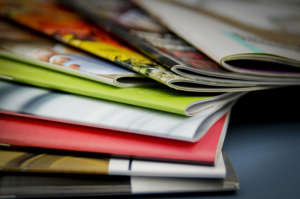A brochure is more than just its message, and its binding is not just a fastener that holds it together. The appearance of your brochure, and the choice you make for binding, is of extreme importance – especially as it pertains to your budget.
The right binding can enhance the shape and durability of the document, and make it more user-friendly for the reader. Transforming your stack of print pieces into an effective promotional booklet may come down to the right binding. There are several different options for binding your brochure, and your first choice may not be the right choice for your particular print piece. Brochure binding options come in all shapes, sizes, and budget ranges – here’s a look at four top brochure binding options that could elevate your print game.
Selecting a Bind Before Designing your Brochure
You do not want your brochure binding to be an after-thought – that could be detrimental to your print project. Consider how long you want the brochure to last, how you want the brochure to open and lay, how bulky it will be, and whether you want it to have a formal or informal appearance. What is the turnaround time producing the brochure with a particular bind? These are factors that you should keep in mind when selecting a bind, and definitely consider before designing your brochure. Your choice in a bind needs to complement your copy, and can help to set the creative done for designing the brochure.
Different Types of Brochure Binding
Saddle Stitching
Saddle stitching is a binding method that’s known for its durability, neat aesthetics, cost-effective advantage, and ability to keep all the content in full view. It’s also called the “two wire stitch” or “stapled spine.” It’s simple in design, but strong enough to hold the pages without any slipping out of position. The folded sheets are gathered together, one inside the other, and then stitched together with metal wire through the fold line or spine from the outside. The wire passes through the spine and the ends are clinched between the center-most pages, forming a staple that encases all of the pages. Saddle stitching is best suited for around 52 pp (printed pages), and you must keep the page count in multiples of 4. A turnaround time of two days is generally needed for production with saddle stitching. It’s not the best binding method for long term use since the stitches can spring open with thicker brochures with a page count over 52.
Tri-fold/Quadfolding
Tri-folds are commonly used for brochures, and on a technical level, the paper is folded a total of two times. It should truly be called “bi-fold,” but the misnomer doesn’t need solving. The name tri-fold is accurate in the sense that the paper is split into thirds, but rather than follow the accordion style of collapsing one panel down, it goes over the other instead. This style is usually called a letter fold since it closely mimics the way business letters are typically folded. The tri-fold is simple and gives order, allowing the reader to view each panel one after the other. This is a cost-effective style and it can be mailed in a standard legal envelope. These brochures are easy to display and hand out, and they can be extremely engaging to readers.
Spiral Binding
Spiral binding, or wire-bound as it’s sometimes called, is a mechanical binding method that uses a pre-formed spiral wire to thread through punched holes in the cover and inner pages. They’re then clamped closed around the printed pages, which are collated and aligned, holding them together. The threading can be done by hand or with an electronic coil inserter- a faster and easier option. Coil crimping pliers are typically used to snip off the end of the coil for a finished look and prevent page slippage. This method is ideal for brochures with more than 20 pages and thickness up to 30mm, and it allows the reader to lay the booklet fully flat and fold it completely in half without losing any of the content in the process. It’s a durable and stylish binding method that can stand out and facilitate heavy use. You have the option of choosing a wire color that pairs well with the overall color scheme of the brochure. Please note that the spine of brochures with spiral binding cannot be printed on.
Rivet Binding
Rivet binding is a method that uses a plastic or mechanical fastener, composed of a head on one end and a cylindrical stem or a tail that resembles a metal pin, to hold pages together. Typically, a stack of paper is punched once in the corner. The rivet is then inserted and the tail is then deformed using a hammer to hold the rivet in place. It provides a stylish finish and appearance. While this is a cost-effective method for binding 20 or more pages, it’s not the best option for someone who’s afraid of working with a little metal.
When designing your brochure, think first about the binding method that you’d like to use. The end product is important for promotional purposes and engaging your audience. Your choice of brochure binding method will either enhance the look of your print material or make it less than desirable. Whether it’s saddle stitch or spiral binding, aesthetics and professionalism are key if you want your brochure to stand out and be effective. For help with brochure printing, and any print marketing project, you can count on the team at Ironmark.




